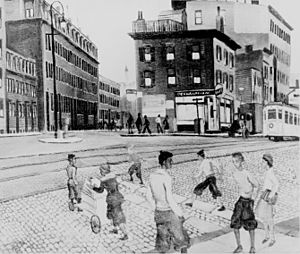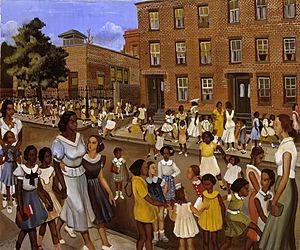Allan Crite facts for kids
Quick facts for kids
Allan Rohan Crite
|
|
|---|---|
| Born | March 20, 1910 |
| Died | September 6, 2007 (aged 97) |
| Nationality | American |
| Alma mater | School of the Museum of Fine Arts, Harvard Extension School |
| Known for | Oils, prints; drafting; author, publisher, and librarian |
| Awards | Harvard University Anniversary Medal |
Allan Rohan Crite (March 20, 1910 – September 6, 2007) was an African American artist. He lived and worked in Boston, Massachusetts. Crite won several awards, including the Harvard University Anniversary Medal.
Contents
Allan Rohan Crite's Life Story
Allan Crite was born in North Plainfield, New Jersey, on March 20, 1910. When he was one year old, his family moved to Boston. He lived in Boston's South End for the rest of his life.
His mother, Annamae, was a poet. She encouraged Allan to draw from a young age. He showed great artistic talent early on. He attended the Children's Art Centre in Boston. Later, he graduated from English High School in 1929. His father, Oscar William Crite, was a doctor and engineer. He was one of the first Black people to get an engineering license.
Crite was accepted into the Yale School of Art. However, he chose to study at the School of the Museum of Fine Arts in Boston. He graduated from there in 1936.
His artwork gained attention early in his career. His art was first shown at New York's Museum of Modern Art in 1936. Later, Crite continued his education at Harvard Extension School. He earned a bachelor's degree in 1968.
Crite was one of the few African Americans who worked for the Federal Art Project. This project helped artists during the Great Depression. In 1940, he started a job as a draftsman at the Boston Naval Shipyard. This job supported his art career for 30 years. He also worked part-time as a librarian at Harvard University.
In 1986, Boston honored him by naming a street intersection after him. It is called Allan Rohan Crite Square. In 1993, Crite married Jackie Cox-Crite. They turned their home into the Crite House Museum. This museum is located at 410 Columbus Avenue in Boston.
Suffolk University gave him an honorary doctorate degree in 1979. Allan Crite passed away peacefully on September 6, 2007, at the age of 97. His wife later created the Allan Rohan Crite Research Institute. This institute helps to protect and organize his many artworks.
Allan Crite's Unique Art Style

Allan Crite wanted to show the lives of African Americans in Boston in a new way. He aimed to paint them as regular people. He showed them as "middle class" citizens, not just as jazz musicians or farmers. Through his art, he wanted to tell the story of African Americans. He showed them as an important part of American society.
Crite used a realistic style of painting. He felt this helped him "report" and capture the true lives of African Americans. He believed their stories were often not fully told.
Crite once explained the main idea behind all his artwork:
I've only done one piece of work in my whole life and I am still at it. I wanted to paint people of color as normal humans. I tell the story of man through the black figure.
His paintings mostly fit into two groups. One group shows religious themes. The other shows everyday African-American experiences. Some people add a third group for his works about Negro spirituals. Crite believed spirituals showed a deep sense of humanity.
Crite was a very religious person. He was a devoted Episcopalian. His faith inspired many of his paintings. For example, his 1946 painting Madonna of the Subway mixes religious and everyday life. It shows a Black Holy Mother and baby Jesus riding Boston's Orange Line subway. Other paintings, like School's Out (1936), focus on community and family life.
Crite's art is known for its rich, earthy colors. One person who studied his work said his favorite color was "all colors." They also said his favorite time of year was "anything but winter." His paintings and drawings are often bright and full of movement. They have fine lines and strong rhythms.
Crite's artworks are displayed in over a hundred places in America. These include the Museum of Modern Art in New York. You can also find his art at the Art Institute of Chicago. The Phillips Collection in Washington also has his work. The Boston Athenaeum has the largest public collection of his paintings. He gave them his art to thank them for letting him be a visiting artist there for many years.
Books by Allan Crite
Allan Crite also illustrated several books:
- Were You There When They Crucified My Lord. A Negro Spiritual in Illustrations (1944)
- All Glory: Brush Drawing Meditations On The Prayer Of Consecration (1947)
- Three Spirituals from Earth to Heaven (1948), where he illustrated religious stories from spirituals like "Swing Low Sweet Chariot" and "Nobody Knows the Trouble I've Seen"
Major Art Exhibitions
Allan Crite's art was shown in many important exhibitions:
- 1920s Harmon Foundation Exhibitions
- 1930s Museum of Modern Art, New York
- 1936 Corcoran Gallery of Art, Washington, D.C.
- 1939 Boston Museum of Fine Arts
- 1978 The Boston Athenaeum
- 1999 Frye Art Museum, Seattle
After he passed away, his works were shown in a series of exhibitions in 2007-2008. These took place at the Boston Public Library, the Boston Athenaeum, and the Museum of the National Center of Afro-American Artists.


